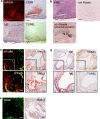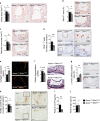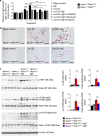Na+-H+ exchanger 1 determines atherosclerotic lesion acidification and promotes atherogenesis
- PMID: 31484936
- PMCID: PMC6726618
- DOI: 10.1038/s41467-019-11983-3
Na+-H+ exchanger 1 determines atherosclerotic lesion acidification and promotes atherogenesis
Abstract
The pH in atherosclerotic lesions varies between individuals. IgE activates macrophage Na+-H+ exchanger (Nhe1) and induces extracellular acidification and cell apoptosis. Here, we show that the pH-sensitive pHrodo probe localizes the acidic regions in atherosclerotic lesions to macrophages, IgE, and cell apoptosis. In Apoe-/- mice, Nhe1-deficiency or anti-IgE antibody reduces atherosclerosis and blocks lesion acidification. Reduced atherosclerosis in Apoe-/- mice receiving bone marrow from Nhe1- or IgE receptor FcεR1-deficient mice, blunted foam cell formation and signaling in IgE-activated macrophages from Nhe1-deficient mice, immunocomplex formation of Nhe1 and FcεR1 in IgE-activated macrophages, and Nhe1-FcεR1 colocalization in atherosclerotic lesion macrophages support a role of IgE-mediated macrophage Nhe1 activation in atherosclerosis. Intravenous administration of a near-infrared fluorescent pH-sensitive probe LS662, followed by coregistered fluorescent molecular tomography-computed tomography imaging, identifies acidic regions in atherosclerotic lesions in live mice, ushering a non-invasive and radiation-free imaging approach to monitor atherosclerotic lesions in live subjects.
Conflict of interest statement
The authors declare no competing interests.
Figures







Similar articles
-
Reduced Nhe1 (Na+-H+ Exchanger-1) Function Protects ApoE-Deficient Mice From Ang II (Angiotensin II)-Induced Abdominal Aortic Aneurysms.Hypertension. 2020 Jul;76(1):87-100. doi: 10.1161/HYPERTENSIONAHA.119.14485. Epub 2020 Jun 1. Hypertension. 2020. PMID: 32475310 Free PMC article.
-
IgE stimulates human and mouse arterial cell apoptosis and cytokine expression and promotes atherogenesis in Apoe-/- mice.J Clin Invest. 2011 Sep;121(9):3564-77. doi: 10.1172/JCI46028. Epub 2011 Aug 8. J Clin Invest. 2011. PMID: 21821913 Free PMC article.
-
LncRNA-induced lysosomal localization of NHE1 promotes increased lysosomal pH in macrophages leading to atherosclerosis.J Biol Chem. 2025 Jun;301(6):110246. doi: 10.1016/j.jbc.2025.110246. Epub 2025 May 16. J Biol Chem. 2025. PMID: 40383150 Free PMC article.
-
IgE Contributes to Atherosclerosis and Obesity by Affecting Macrophage Polarization, Macrophage Protein Network, and Foam Cell Formation.Arterioscler Thromb Vasc Biol. 2020 Mar;40(3):597-610. doi: 10.1161/ATVBAHA.119.313744. Epub 2020 Jan 30. Arterioscler Thromb Vasc Biol. 2020. PMID: 31996021 Free PMC article.
-
Insulin-Like Growth Factor-1 Receptor Deficiency in Macrophages Accelerates Atherosclerosis and Induces an Unstable Plaque Phenotype in Apolipoprotein E-Deficient Mice.Circulation. 2016 Jun 7;133(23):2263-78. doi: 10.1161/CIRCULATIONAHA.116.021805. Epub 2016 May 6. Circulation. 2016. PMID: 27154724 Free PMC article.
Cited by
-
pH sensing at the intersection of tissue homeostasis and inflammation.Trends Immunol. 2023 Oct;44(10):807-825. doi: 10.1016/j.it.2023.08.008. Epub 2023 Sep 14. Trends Immunol. 2023. PMID: 37714775 Free PMC article. Review.
-
Atherosclerosis: The Involvement of Immunity, Cytokines and Cells in Pathogenesis, and Potential Novel Therapeutics.Aging Dis. 2023 Aug 1;14(4):1214-1242. doi: 10.14336/AD.2022.1208. Aging Dis. 2023. PMID: 37163428 Free PMC article. Review.
-
Cardiomyocyte-specific NHE1 overexpression confers protection against myocardial infarction during hyperglycemia.Cardiovasc Diabetol. 2025 Apr 26;24(1):184. doi: 10.1186/s12933-025-02743-3. Cardiovasc Diabetol. 2025. PMID: 40287728 Free PMC article.
-
Sensing Mechanism and Excited-State Dynamics of a Widely Used Intracellular Fluorescent pH Probe: pHrodo.J Phys Chem Lett. 2023 Nov 23;14(46):10482-10488. doi: 10.1021/acs.jpclett.3c02653. Epub 2023 Nov 15. J Phys Chem Lett. 2023. PMID: 37967406 Free PMC article.
-
Oxidative stress biomarker triggered multiplexed tool for auxiliary diagnosis of atherosclerosis.Sci Adv. 2023 Oct 13;9(41):eadh1037. doi: 10.1126/sciadv.adh1037. Epub 2023 Oct 13. Sci Adv. 2023. PMID: 37831761 Free PMC article.
References
Publication types
MeSH terms
Substances
Grants and funding
LinkOut - more resources
Full Text Sources
Medical
Molecular Biology Databases
Miscellaneous

